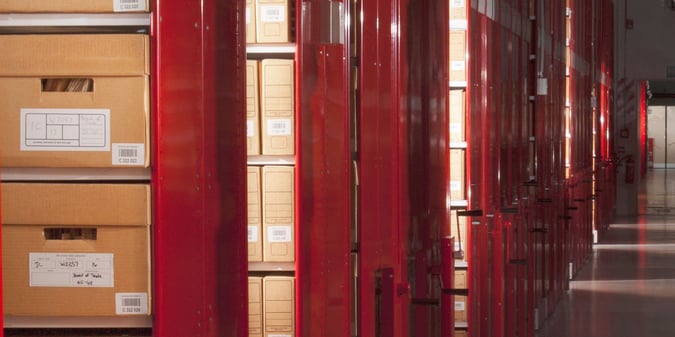
“Out of Sight” should not mean “Out of Mind.” The worst happens when we least expect it. While it’s great that library items are stored in safe locations, it’s essential that these facilities be included in security, risk management, and disaster response plans.
Locating lesser used and fragile documents, files, boxes, and objects in off-site and remote storage facilities has become commonplace, especially in overcrowded library buildings and court houses. Now we have to include these collections in our emergency, risk management, and disaster response plans.
Disasters Happen
Imagine that your remote storage facility is located in a rural area in eastern South Carolina. The recent storm, Florence, dumped many inches of rain on the countryside—rain which has run into streams and rivers. These waterways are now overflowing and flooding towns and villages that were dry just a week before.
If you’ve included your remote storage facility in your institution’s disaster response plan you are in luck. If not, you’ll be depending upon digitized images of materials from now on. Or you will have to wait for the water to subside and then inventory what’s left of the paper collections. Your disaster response plan should kick in and you should start organizing how you’ll dry out the materials in storage. Even if you don’t have a disaster response plan, don’t wait! Contact the cultural heritage emergency hotlines and begin to dry out your collections.
It’s essential that you include any off-site and remote storage facilities you utilize when you design your disaster response plan and risk audit. Whether you own the facility or rent, it’s still a place where you house your irreplaceable materials, lesser used items, fragile objects, and perhaps vital and historically significant records. If you haven’t included these facilities in your planning, if you haven’t considered potential risks to the collections, you haven’t finished planning.
Plan for every day disaster and build up to the “worst” scenarios
There are lots of manuals and publications on the market to help you plan for disasters and prevent them. What’s more important than owning these guides is to actually put their advice into practice. I’ve provided a short list of resources at the end of this post.
The disaster response team should tour any off-site and remote storage facilities. Look for potential hazards such as the location of water pipes, types of roofs, visible structural damage like cracks and leaks, and any potential hazards around the perimeter like streams and even gullies.
A current inventory of all materials stored in the off-site and remote storage facilities is a must. Ask if the facility can produce an inventory upon request. Ask if they can access the inventory remotely in case of disaster. Can your institutional catalog or database produce a report of all items stored off-site? How easy is it to run such a report? Identifying items that are in transit to and from the remote storage facility is also important.
Discussing Risk and Disaster Response
Discuss disaster response planning with the facility manager. Do they have a plan? How have they planned to prevent damage from water and fire? Who do they contact in case of a disaster? You want to be included in the contact list and to have a good idea of how they plan to respond when a disaster occurs.
Have a discussion with your risk manager about storage of materials off-site. Ask how the insurance policy cover the collections and make certain off-site materials are included. Just because the remote storage facility has insurance doesn’t mean tenant and lessee contents are covered.
Security
It goes without saying that off-site and remote storage facilities should have some type of security on site. Do they have an alarm system? Guards in the case of art and museum collections? Emergency lighting and emergency response procedures? Ask lots of questions while at the off-site and remote storage facility. Examples of questions are:
- Who has access to the collections when the facility is open and at night?
- Are there protocols for handling fragile and rare items?
- Are materials housed anonymously in record storage boxes with barcodes only?
- Who is contacted when there’s an emergency, break-in, or disaster?
Take your security staff and their supervisor on a tour of the remote storage facility. What types of questions does the tour raise for the security staff?
Summing it up
Remember, a disaster response and prevention plan includes all locations where collections are housed; on-site, off-site and in remote storage facilities. Solid, well-thought out response plans make the disaster easier to handle and respond to in an efficient and effective manner. Libraries, archives, museums, and municipal and courthouse record centers are all vulnerable to disaster. Off-site and remote storage facilities should always be included in your disaster response plan. They should never be an afterthought.
My next blog post will look at the origins of off-site and remote storage centers for libraries, archives, and record centers.
Resources for information about disaster response and planning
ARMA. inDEPTH: Business Continuity and Disaster Recovery. (in April 2018 issue of inDEPTH)
Federal Depository Library Program (US Government Documents) “What To Do If Your Depository Faces A Disaster” (October 12, 2017)
Kahn, Miriam Disaster Response and Planning for Libraries, Third Edition (Chicago: American Library Association, 2012 ISBN 978-0-8389-1151-8)
Mallery, Mary. Technology Disaster Response and Recovery Planning: A LITA Guide (Chicago: ALA / Neal Schuman, 2015 ISBN 978-0-8389-1315-4)
Northeast Document Conservation Center (NEDCC) Emergency Management Leaflets Smithsonian Cultural Rescue Initiative, Hurricane Preparedness Tips For Cultural Institutions: A one-page document that provides tips for preparing and responding to hurricanes. Wilkinson, Frances C, Linda K. Lewis, and Nancy K. Dennis. Comprehensive Guide to Emergency and Disaster Preparedness and Recovery (Chicago:ACRL, ALA, 2009 ISBN 978-0-8389-8548-9)
Organizations that will help in an emergency:
National Heritage Responders: AIC - A group of volunteers located across the country who coordinate their efforts in the event of a disaster.
Ready.gov - preparing for emergencies and disasters for individuals.
Smithsonian Cultural Rescue Initiative, Hurricane Preparedness Tips For Cultural Institutions: A one-page document that provides tips for preparing and responding to hurricanes.


